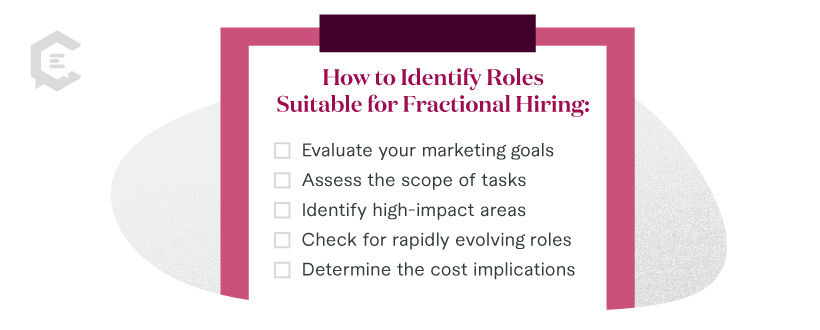Six out of 10 — that’s the number of marketers who say their marketing budget is being scrutinized somewhat more or much more now compared to previous years.
This comes as no surprise; any business leader worth their salt wants to know they’re investing in the smartest, most effective, and flexible marketing strategies available. With all eyes on getting the best bang for their buck, many companies are now looking at fractional hiring as the way to go.
In this guide, we’ll examine fractional hiring, why it makes sense, and some implementation best practices for integrating fractional roles into your existing team.
The Shift to Fractional Hiring
During economic uncertainties, when every business tries to tighten the belt on expenses, bringing in fractional talent can be a game changer. It keeps your essential operations running smoothly without the hefty price tag of full-time experts.
Done right, it’s a cost management technique you can leverage to squeeze the most value out of your marketing budget.
To illustrate, take a look at these examples of fractional hiring in action:
How our marketing team leverages fractional talent
At ClearVoice, our marketing team shifted its strategy partly due to budget constraints. (We all know there are ongoing challenges, but this is always a staple.) Our paid ads budget had been maxed out, so we decided to focus on earned and outbound channels. But, executing these programs required expertise in several areas — SEO, content strategy, and multimedia production, among others. Instead of hiring a unicorn of a person to take care of everything, we onboarded four different fractional pros so each could focus on their area of expertise.
The result? A 30 percent increase in sales qualified leads (SQLs) and a 40 percent decrease in overall marketing spend. Not too shabby, ehh?!
Fractional CMO for a software consulting company
Lesly Cardec, SVP at ClearEdge Marketing, helped a software consulting firm find an experienced CMO to position them for acquisition. They had a marketing team, but the crew was pretty green and not quite ready to handle the big leagues of prepping the company for acquisition.
Enter the fractional CMO, who jumped in for just about four months. In that short time, they revamped the martech stack, fine-tuned the brand messaging, sharpened the positioning, and overhauled various strategies. The software company couldn’t have been happier with the high-level expertise and mentorship they got. It was a total game-changer for their strategic objectives.
And while a C-level fractional hire might seem like the go-to solution, it’s super important to really understand what your team needs first. In this scenario, the team was young and missing the deep expertise needed at the top. But often, it’s the other way around — you might find that you’ve got plenty of top-level leaders but not enough hands-on folks to actually execute the plans. Look at your team’s structure and skills gaps before deciding on your next move.
How We Integrated Fractional Hiring Into Our Marketing Strategy
In marketing, roles like content strategists, digital marketing experts, PR specialists, fractional CMOs, and brand consultants can be ideal for fractional hiring. These positions often require specialized skills that are not necessarily needed on a full-time basis but are critical during specific stages of a marketing campaign or project.
Here’s how to identify roles suitable for fractional hiring:
- Evaluate your marketing goals: Review your short-term and long-term marketing objectives. What skills are necessary to achieve these goals?
- Assess the scope of tasks: Pinpoint areas that need improvement or require specialized skills that your team lacks. This could be anything from SEO, content marketing, or data analytics. Take note that these have to be project-based or don’t require full-time commitment.
- Identify high-impact areas: Find areas in your marketing strategy that can benefit from expert input. Typically, these are high-impact, high-value areas where expert knowledge can drive substantial ROI improvements, such as brand positioning or digital marketing strategy.
- Check for rapidly evolving roles: Fields such as SEO and social media are rapidly evolving, and fractional hires with up-to-date expertise can provide significant benefits.
- Determine the cost implications: Compare the costs of hiring a full-time employee (FTE) versus a fractional professional. Roles that don’t justify FTE expenses and benefits but are critical for your marketing success are suitable for fractional hiring.
Once you’ve pinpointed the roles you need to fill, start scouting for fractional execs or pros who specialize in those areas. You can find them on LinkedIn, at networking events, or through recruitment agencies.
When screening candidates, don’t just focus on their experience and skills. Make sure they vibe well with your company culture and can gel with your current team.
If your content needs tend to change from month to month, or if you’re looking for more project-based marketing help that stretches beyond just whipping up content, give ClearVoice Flex a look. It’s a flexible solution that leverages fractional talent to help you fill in-house marketing gaps.
How We Integrated Fractional Talent Into Our Existing Team
Hiring the best fractional talent — or, in the case of Flex, a flexible content partner — is just the first step. Next is helping them blend smoothly into your team. That means using the proper leadership strategies with fractional workers.
To ensure your new fractional employees hit the ground running and have everything they need to get things done just the way you want them to, consider the following tips:
Clarify roles and responsibilities
Before they start, clearly define the new hire’s roles and responsibilities. Ensure your team understands these to prevent any overlaps or conflicts. Both fractional and full-time employees must know the scope of work and how they fit into the overall strategy.
Onboard properly
Even though they’re only with you part-time, onboard your fractional hires like they’re full-time. Get them set up with all the tools and resources they need, and make sure to introduce them to the team. If you can, plug them into ongoing projects right away — it helps them feel like they’re a real part of the team from the get-go.
Establish communication protocols
Set up regular check-ins on platforms like Slack or Microsoft Teams to keep everyone connected and informed. Make it clear how quickly you expect replies — emails within 24 hours and messages on Slack or Asana within an hour or two.
Clearly communicate availability hours
It’s super important for fractional hires, especially if they’re in different time zones or schedules. Encourage them to use those ‘availability’ features to show when they’re around. It keeps everyone in sync and avoids any unnecessary confusion.
Set performance metrics
Make sure your fractional hires know what they’re aiming for. Set clear performance goals and metrics, and remember to touch base regularly. Feedback sessions help them see how they’re doing and adjust their game plan as needed.
Examples of metrics to track for different types of fractional hires:
- CMO: Number of new leads, improvement in brand awareness via surveys or media appearances, ROI from specific marketing campaigns, reduction in customer acquisition cost
- Social media manager: Engagement rate (likes, comments, social shares), follower growth, amount of traffic from social media to website
- SEO specialist: Improvement in rankings for targeted keywords, increase in organic traffic, number of new backlinks acquired, increase in conversion rates
General metrics that are applicable across roles:
- Project completion: Milestones achieved, on-time completion rate, quality of deliverables
- Quality of work: Client satisfaction scores, peer review scores, rework rate
- Contributions to process improvements: Number of improvement suggestions made, implementation rate of suggested improvements, frequency of awards or recognition for proactive actions or contributions
- Overall teamwork: Peer reviews, engagement and contribution in meetings, completion rate for tasks that require team collaboration
Leverage their expertise
Encourage your existing team to see the fractional talent as a resource. Their expertise, likely in a specialized area, can be a valuable learning opportunity for everyone. Promote knowledge sharing through workshops, training sessions, or one-on-one mentorships.
Manage expectations
Make sure everyone — both full-time folks and fractional team members — knows what’s expected in terms of results and how they should be working together. Being upfront about this can help nip any potential tension in the bud and boost team collaboration.
Enhance loyalty and commitment
Don’t forget to give a shoutout to your fractional hires for their hard work. Everyone likes a bit of recognition — it really ramps up motivation. Plus, loop them into key decisions when it makes sense. It shows you value their input, and honestly, their fresh perspectives might just be the spice your strategy needs.
Review and adjust
Keep tabs on how things are meshing together and tweak as you go. It’s a good idea to regularly check in and see how your full-time and fractional employees feel about the integration. Use their feedback to determine where you can make improvements.
Stay flexible with your hiring strategy. Depending on how things are working out and what your business needs at the moment, you might need to switch up the roles of your fractional hires or adjust their hours to better suit the company’s needs.
Maximize Your Marketing Budget with Fractional Hires
With more and more skilled professionals engaging in part-time or freelance work, fractional hiring offers an effective way for businesses to gain access to specialized skills — but without the cost and complications associated with full-time hiring. Organizations can remain agile and competitive while keeping their operational costs under control.
Ready to elevate your content marketing strategy without breaking the bank? Connect with a ClearVoice specialist today to discuss how our various content solutions can help.









